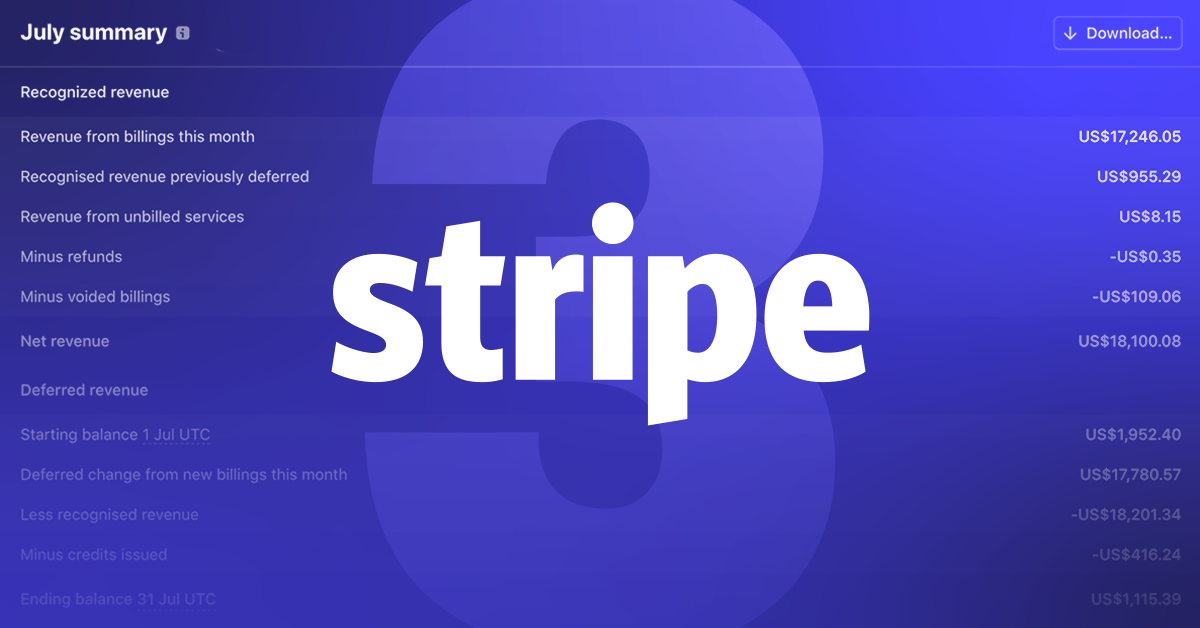Stripe’s out-of-the-box reporting creates extra work for accountants to organize and complete transaction information to make it suitable for revenue reporting and month-end close.
But it’s not just a matter of extra work. These Stripe reporting challenges can create serious issues around performing reconciliation and accurate, timely month-end close.
Here are three top challenges accountants have with Stripe reporting:
1. Stripe reports aren’t organized for accounting
To get all of the transaction data out of Stripe needed for month-end close, accountants need to do some running around. Accountants need to get a Cash report, Payout Report, Refund Report, Disputes Report, and Credits Report. These are all separate reports in Stripe, and the level of data in reports can be inconsistent with what’s available through the Stripe dashboard (the fact that more transaction data is available to developers via the API than to accounting teams in the dashboard is a topic for another day).
All of the data from those separate reports then needs to be dumped into Excel and VLOOKUPs must be done to aggregate and organize it. Then it still all needs to be reconciled to cash.
2. Stripe discount data makes life difficult for accountants
For businesses that offer discounts, many require discount data at the individual transaction level, or line item level. But Stripe only provides this data at the total invoice level. Once again, the burden falls on accountants to perform those calculations to produce the line item discounts. Without a tool like Leapfin, they are doing this work manually, likely in their already-maxed-out Excel sheets.
3. Stripe metadata isn’t appended properly for accounting
In Stripe, important metadata often isn’t where accountants would like to find it. For example, location data sits in payments, but accountants need that data for all other transactions as well. This means accountants need to organize and append location data across all appropriate transaction types manually.
Fragmented Stripe data isn’t just a minor frustration. The time and energy it takes to properly manage this data and make it accounting-ready can negatively impact Accounting teams’ process and output.
Stripe reporting creates issues with reconciliation
- Connected Accounts: To reconcile cash, accountants have to take the additional step to pull reports for connected accounts.
- FX (Foreign Exchange): If you have multiple Stripe instances, they can have different reporting currencies, functional currencies, and record currencies. While Stripe converts these at settlement, tying out can be difficult depending on your reporting requirements.
These reconciliation challenges can lead to inaccuracies in revenue reporting, affecting decision-making and compliance and inviting additional scrutiny.
Stripe reporting slows down month-end close
Raw Stripe data creates an inefficient month-end close. Stripe does provide much of the necessary transaction data accountants need for month-end close. The problem is that raw Stripe data is also more than accountants need for month-end close. When all that raw Stripe data is pulled down into Excel (or Google sheets), it quickly maxes out those workbooks and sheets, causing major loading delays (spinny wheel of death) and, worse, crashes.
Raw data requires an intense amount of manipulation. And without automated segmentation and enrichment, that manipulation has to be done manually. That means time and errors. Delayed reporting erodes confidence in the accounting data and process, and makes the data effectively useless for timely business insights and operational decisions.
Real-world examples
The above examples aren’t just hypothetical. Here are three examples of real businesses who experienced real pain caused by Stripe reporting challenges before they adopted Leapfin. The names have been made anonymous, but these are real customers who use Stripe and Leapfin:
Customer A - a CMS and website hosting business
Customer A’s marketing team decided to go rogue on their use of product_ids, creating product_ids for campaigns, discounts, and all sorts of things. Because Stripe isn’t built for accounting, Customer A’s accounting team needed to create a 4000-line mapping file to try to filter out non-revenue product_ids to ensure correct accounting. This is a problem Leapfin solves for Customer A.
Customer B - a car rental business
While Stripe collects sales tax, it also allows for local taxes to be charged to a customer through invoice line detail. This became really complex for Customer B in the car rental business, where a single rental might have sales tax, a gas tax, a municipal tax, and even a state tax. In Stripe, this data sits in different places and has different relationships to the payment, making geo-level and tax reporting complex and painful. This is a problem that Leapfin solves for Customer B.
Customer C - a content creation business
To get any level of settlement reporting, Customer C has to do a balance transaction look-up. This involves over a million lines of transaction data, performed several times a month. Excel is a nightmare for this type of exercise. This is a problem that Leapfin solves for Customer C.
For efficient and accurate revenue reporting and month-end close, accountants need accounting-ready data. Stripe isn’t built for accounting, but Leapfin is. Leapfin automates all of the tedious but necessary preparation tasks and transforms raw Stripe data into accounting-ready information. Take a spin through this 11-point checklist to see if your team and process are ready for accounting automation.
